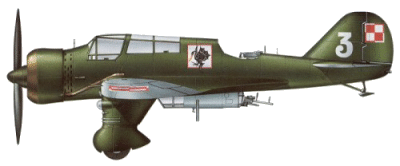
During 1931 P.Z.L. had
designed a six-passenger single-engine light transport, the P.Z.L.
P.13, for service with LOT, but as it had no appeal to the airline its
development was abandoned. It was decided subsequently to use this
aircraft as the basis for an army co-operation aircraft accommodating a
crew of three, and using as powerplant a licence-built version of the
Bristol Pegasus radial engine. Following evaluation of the design by
the Department of Aeronautics, P.Z.L. was instructed to build three
prototypes and the first, powered by a Skoda licensed built 590 hp (440
kW) Bristol Pegasus IIM2 engine driving a two bladed wooden propeller,
was flown for the first time in August 1934. This aircraft had the
designation P.23/I and name Karas (crucian carp), but testing
soon revealed a number of shortcomings.

The two following
prototypes, P.23/II and P.23/III, had the engine mounting lowered to
improve the forward view, the bomb bay was deleted to provide more room
within the fuselage, and improved glazed canopies were introduced,
together with a number of other improvements. The P.23/II crashed
during flight trials, but the P.23/III performed well and during
development flying was modified progressively to what was to be
production standard. In 1935 production orders were placed for 40
examples of the P.23 Karas A with the 580 hp (433 kW) P.Z.L. built
Pegasus II, and 210 of the P.23 Karas B with the 680 hp (507 kW) P.Z.L.
built Pegasus VIII.

The first P.23A Karas A
flew in June 1936, but development problems with the Pegasus II engine
resulted in these aircraft being relegated to the training role,
However, the P.23B Karas B began to enter service in mid-1937 and when
production ended the type equipped 14 first-Iine squadrons. One Karas B
was modified under the designation P.42 to serve as a development
aircraft for the improved P.46 Sum, with a twin fin/rudder tail unit
and a retractable ventral gondola. However, the P.46 did not
materialise beyond the prototype stage and the P.42 was subsequently
converted back to Karas B standard.
One other version
similar to the Karas B entered production, however, as the P.43A Karas,
of which 12 were built for the Bulgarian air force and delivered in
1937. This model differed by having the 930 hp (694 kW) Gnome-Rhône
radial engine, improved crew accommodation, and armament increased by
the addition of a second forward-firing machine-gun. The excellent
performance of the P.43A Karas led to repeat orders, totalling 42, for
a further improved P.43B Karas with the 980 hp (731 kW) Gnome-Rhône
N.1. Of this total 33 were dispatched and delivered by August 1939; of
the balance, eight had been packed for despatch and the ninth was in
final assembly. With the outbreak of World War II, these aircraft were
seized for service with the Polish air force, but only five survived
the initial German bombing attacks on the P.Z.L. factory and were flown
off to serve with No. 41 Squadron, one of the 12 front line squadrons
then equipped with P.23B Karas B aircraft. These squadrons were
responsible for the bulk of the bombing and reconnaissance operations
of the Polish air force during the first 16 days of September 1939, but
their aircraft were terribly vulnerable to German opposition and
virtually 95 per cent of them were destroyed in action.
Variants
PZL P.23 Karas A - In
1935 production orders were placed for 40 examples of the P.23 Karas A
with the 580 hp (433 kW) P.Z.L. built Pegasus II engine.
PZL P.23 Karas B - 210
aircraft of the P.23 Karas B with the 680 hp (507 kW) P.Z.L. built
Pegasus VIII engine were built.
PZL P.42/PZL P.46 Sum -
One Karas B was modified under the designation P.42 to serve as a
development aircraft for the improved P.46 Sum, with a twin fin/rudder
tail unit and a retractable ventral gondola. However, the P.46 did not
materialise beyond the prototype stage and the P.42 was subsequently
converted back to Karas B standard.
PZL P.43A Karas - 12
were built for the Bulgarian air force and delivered in 1937. This
model differed by having the 930 hp (694 kW) Gnome-Rhône radial engine,
improved crew accommodation, and armament increased by the addition of
a second forward-firing machine-gun.
PZL P.43B Karas - The
further improved P.43B Karas with the 980 hp (731 kW) Gnome-Rhône N.1.
Of this total 33 were dispatched and delivered by August 1939; of the
balance, eight had been packed for despatch and the ninth was in final
assembly.
Specifications (PZL
P.23 Karas B)
Type: Army
Co-operation & Light Attack
Design:
Panstwowe Zaklady Lotnicze Design Team led by Stanislaw Prauss
Manufacturer:
Panstwowe Zaklady Lotnicze in Poland
Powerplant: One
680 hp (570 kW) P.Z.L. built Bristol Pegasus VIII radial engine.
Performance:
Maximum speed 199 mph (320 km/h) at 11,975 ft (3650 m); service ceiling
23,950 ft (7300 m).
Range: 783 miles
(1260 km) on internal fuel.
Weight: Empty
equipped 4,251 lbs (1938 kg) with a maximum take-off weight of 7,771
lbs (3525 kg).
Dimensions: Span
45 ft 9 1/4 in (13.95 m); length 31 ft 9 3/4 in (9.70 m); height 10 ft
10 in (3.30 m); wing area 288.48 sq ft (26.80 sq m).
Armament: One
7.7 mm (0.303 in) forward firing Browning or KM Wz 33 machine gun, and
two single Browning or KM Wz 33 machine guns of similar calibre in rear
dorsal (PZL hydraulically assisted mount) and ventral positions, plus
up to 1,543 lbs (700 kg) of bombs on external racks.
Variants: P.23
Karas A, P.23 Karas B, P.42/P.46 Sum, P.43A Karas, P.43B Karas.
Avionics: None.
History: First
flight (prototype) August 1934; first flight (P.23 Karas A) June 1936;
entered service (P.23 Karas B) mid 1937.
Operators:
Poland, Bulgaria, Romania. |
